Composition and structure of calcium-phosphate coatings on Ti3AlC2 produced by sol-gel synthesis
Abstract
Calcium phosphate materials have been widely used in medical practice for decades. Due to their bioactivity and integration with human hard tissues. They have been produced in the form of dense and porous ceramics, powders and needle-like crystals (whiskers). Despite the high mechanical properties (hardness, compressive strength), calcium phosphate ceramics are mainly used in medicine mainly as the fillers for bone defects formed due to injuries or diseases because they have high fragility and low crack resistance. These circumstances do not allow using them in the sites that have high mechanical loads (e.g. hip surgery). To solve these problems metal implants are used. Among them, Ti-based alloys are the most widely used due to its high mechanical properties, biocompatibility and high corrosion resistance. Recently, the data on the use of MAX phases as medical materials to create the composites based on Ti3SiC2 have appeared in the literature.
Calcium phosphate coatings were obtained on Ti3AlC2 substrate by the sol-gel method. The effect of temperature, holding time, chemical compositions of reactants on the phase composition and structure of the samples are discussed. XRD measurements have revealed that the initial coatings consists of nanoparticles sized 10-50 nm. Light and scanning electron microscopy (SEM) were applied to study the morphology of the coatings. It have been shown that the coatings had thickness in an interval 40-100 mm and had the homogenous structure. It has been established by X-ray phase identification that the coating after heating at 1000oC during 1 hour contained b-tricalcium phosphate (b-TCP). It was found, that the thickness and phase composition of coatings depend on the time of coating in calcium phosphate solution. The optimal conditions for the formation of coatings are established.
Downloads
References
2. S. Zhang. Hydroxyapatite coatings for biomedical applications, CRC Press (2013), 463 p.
3. V. S. Gshalaev, A. C. Demirchan. Hydroxyapatite: Synthesis, Properties and Applications, Nova science publishers (2012), 493 p.
4. Y. Oshida. Hydroxyapatite: Synthesis and Applications, Momentum Press (2014), 220 p.
5. L. L. Hench. An introduction to bioceramics - 2nd edition, Imperial College Press (2013), 597 p.
6. J. Park, R. S. Lakes. Biomaterials. An Introduction, Springer (2010), 564 p.
7. B. Ben-Nissan. Advances in Calcium Phosphate Biomaterials, Springer (2014), 559 p.
8. K. de Groot. Bioceramics of calcium phosphate, CRC Press (1983), 153 p.
9. P. Van Landuyt, F. Li, J.P. Keustermans, J. M. Streydio, F. Delannay, E. Munting. The influence of high sintering temperatures on the mechanical properties of hydroxylapatite, J. Mater. Sci.: Mater. in Med.,6, 8 (1995).
10. M. Jarcho, C.H. Bolen, M.B. Thomas, J. Bobick, J.F. Kay, R.H. Doremus. Hydroxylapatite synthesis and characterization in dense polycrystalline form, J. Mater. Sci., 1976, 11, 2027.
11. R. Tolouei, R. Singh, I. Sopyan, T.C. Yong, M. Amiriyan, T.W. Dung. Dependence of the Fracture Toughness on the Sintering Time of Dense Hydroxyapatite Bioceramics, Mat. Sci. For., 694, 391 (2011).
12. A. Goharian, M.R. Abdullah. Bioinert Metals (Stainless Steel, Titanium, Cobalt Chromium),Trauma Plating Systems(2017), 115 p.
13. J. Enderle, J. Bronzino. Introduction to Biomedical Engineering, 3rd Edition, Academic Press, (2011), 1270 p.
14. N.F. Gao, Y. Miyamoto, H. Oonishi, D. Zhang. Investigation on the application of Ti3SiC2 ceramics for biomaterials, J. Mater. Sci. Lett., 21, 783 (2002).
15. T. L. Ngai, L. Lua, J. Chen, Junhong Zhang, Yuanyuan Li. Preparation of SiC reinforced Ti3SiC2-base composite and its biocompatibility evaluation, Ceram. Int., 40, 5343 (2014).
16. K. Chen, N. Qiu, Q. Deng, M.-H. Kang, H, Yang, J.-U. Baek, Y.-H. Koh, S. Du, Q. Huang, H.-E. Kim, Cytocompatibility of Ti3AlC2, Ti3SiC2, and Ti2AlN: In vitro Tests and First-principles Calculations, ACS Biomater. Sci. Eng., 3, 10, 2293, (2017).
17. M.W. Barsoum. The MN+1AXN Phases: A New Class of Solids, Frog. Solid St. Chem., 28, 201 (2000).
18. S.L. Shi, W. Pan, M.H. Fang, Z.Y. Fang. Reinforcement of Hydroxyapatite Bioceramic by Addition of Ti3SiC2, J. Am. Ceram. Soc., 89, 743 (2006).
19. S. L. Shi, W. Pan. Machinable Ti3SiC2/Hydroxyapatite Bioceramic Composites by Spark Plasma Sintering, J. Am. Ceram. Soc., 90, 3331 (2007).
20. Y.I. Boyko, V.V. Bogdanov, R.V. Vovk, E.S. Gevorkyan, V.A. Kolesnichenko, V.F. Korshak, T.A. Prikhna. Thermal and crack resistance of ceramics based on the MAX phase Ti3AlC2, Functional Materials, 25, 708 (2018).
21. A. Dehghanghadikolaei, B. FotovvatiCoating. Techniques for Functional Enhancement of Metal Implants for Bone Replacement: A Review, Materials, 12, 1795 (2019).
22. Z.Z. Zyman, D.V. Rokhmistrov, V.I. Glushko. Structural and compositional features of amorphous calcium phosphate at the early stage of precipitation, J. Mater. Sci: Mater. Med., 21, 123 (2010).
23. ICDD (2004). PDF-2 2004. International Centre for Diffraction Data, Newtown Square, PA, USA.








3.gif)
